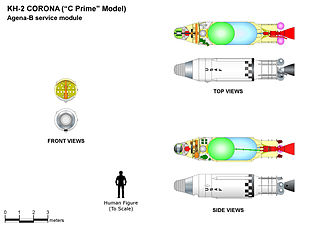Thor was a US space launch vehicle derived from the PGM-17 Thor intermediate-range ballistic missile. The Thor rocket was the first member of the Delta rocket family of space launch vehicles. The last launch of a direct derivative of the Thor missile occurred in 2018 as the first stage of the final Delta II.
Kosmos 76, also known as DS-P1-Yu No.3 was a Soviet satellite which was used as a radar calibration target for tests of anti-ballistic missiles. It was built by the Yuzhnoye Design Bureau, and launched in 1965 as part of the Dnepropetrovsk Sputnik programme.
Kosmos 101, also known as DS-P1-Yu No.4 was a Soviet satellite which was used as a radar calibration target for tests of anti-ballistic missiles. It was built by the Yuzhnoye Design Bureau, and launched in 1965 as part of the Dnepropetrovsk Sputnik programme.
Kosmos 95, also known as DS-U2-V No.2, was a Soviet satellite which was launched in 1965 as part of the Dnepropetrovsk Sputnik programme. The spacecraft weighed 325 kilograms (717 lb), and was built by the Yuzhnoye Design Office, and was used to conduct classified technology development experiments for the Soviet armed forces.
OPS 3762, also known as FTV-2355, was an American reconnaissance satellite which was launched in 1964. It was the first radar imaging satellite to be launched, and the only Quill spacecraft to fly. Its mission was to demonstrate radar imaging techniques for future missions. However, the programme was cancelled before any more satellites were launched.
FTV-2203, also known as Samos 5, was an American reconnaissance satellite launched in 1961 as part of the Samos programme. It was a film return reconnaissance spacecraft, meaning that it returned images in a film capsule at the end of its mission. FTV-2203 was a Samos-E5 spacecraft, based on the Agena-B. It carried a camera with a focal length of 1.67 metres and a resolution of 1.5 metres.

Discoverer 17, also known as Corona 9012, was an American optical reconnaissance satellite launched on 12 November 1960 at 20:38:00 GMT. It was the second of ten Corona KH-2 satellites, based on the Agena-B.

Discoverer 18, also known as Corona 9013, was an American optical reconnaissance satellite launched on 7 December 1960 at 20:24:00 GMT. It was the first successful, and the third of ten total Corona KH-2 satellites, based on the Agena-B.
Discoverer 21, also known as RM-2, was an American satellite which was launched in 1961. It was a technology demonstration spacecraft, based on an Agena-B.
Discoverer 19, also known as RM-1, was an American satellite which was launched in 1960. It was a technology demonstration spacecraft, based on an Agena-B.

Transit 3B was an American satellite which was launched in 1961 and operated by the United States Navy. It was a replacement for Transit 3A, which was lost in a launch failure the previous year. It carried instruments to demonstrate navigation and timing systems, and study geodesy to support the development of the Transit satellite navigation system.

Pegasus 1 or I, known before launch as Pegasus A, was an American satellite which was launched in 1965 to study micrometeoroid impacts in low Earth orbit. It was the first of three Pegasus satellites to be launched. The Pegasus spacecraft were manufactured by Fairchild Hiller, and operated by NASA.

Pegasus 2 or Pegasus II, known before launch as Pegasus B was an American satellite which was launched in 1965 to study micrometeoroid impacts in Low Earth orbit. It was the second of three Pegasus satellites to be launched, following the launch of Pegasus 1 three months earlier. The Pegasus spacecraft were manufactured by Fairchild Hiller, and operated by NASA.

Pegasus 3 or III, also known as Pegasus C before launch, was an American satellite which was launched in 1965 to study micrometeoroid impacts in Low Earth orbit. It was the last of three Pegasus satellites to be launched, the previous two having been launched earlier the same year. It was manufactured by Fairchild Hiller, and operated by NASA.

TD-1A, or Thor-Delta 1A, was a European astrophysical research satellite which was launched in 1972. Operated by the European Space Research Organisation, TD-1A made astronomical surveys primarily in the ultraviolet, but also using x-ray and gamma ray detectors.
Kosmos 35 or Zenit-2 No.21 was a Soviet, first generation, low resolution, optical film-return reconnaissance satellite launched in 1964. A Zenit-2 spacecraft, Kosmos 35 was the twentieth of eighty-one such satellites to be launched and had a mass of 4,730 kilograms (10,430 lb).
Kosmos 37 or Zenit-2 No.22 was a Soviet, first generation, low resolution, optical film-return reconnaissance satellite launched in 1964. A Zenit-2 spacecraft, Kosmos 37 was the twentieth of eighty-one such satellites to be launched and had a mass of 4,730 kilograms (10,430 lb).
Kosmos 68 or Zenit-2 No.29 was a Soviet, first generation, low resolution, optical film-return reconnaissance satellite launched in 1965. A Zenit-2 spacecraft, Kosmos 68 was the twenty-eighth of eighty-one such satellites to be launched and had a mass of 4,730 kilograms (10,430 lb).
Kosmos 78 or Zenit-2 No.30 was a Soviet, first generation, low resolution, optical film-return reconnaissance satellite launched in 1965. A Zenit-2 spacecraft, Kosmos 78 was the thirtieth of eighty-one such satellites to be launched and had a mass of 4,730 kilograms (10,430 lb).
Kosmos 104 or Zenit-2 No.36 was a Soviet first-generation low-resolution optical film–return reconnaissance satellite launched in 1966. A Zenit-2 spacecraft, Kosmos 104 was the thirty-second of eighty-one such satellites to be launched and had a mass of 4,730 kilograms (10,430 lb).





